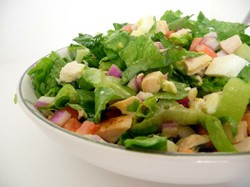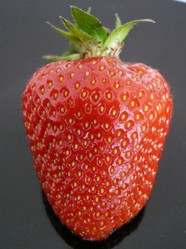
The Myths About Salads
by WebWriter
There are several myths about salad, including that all salads are good for you. Not all salads are good for you and not all salads are calorie free.
5 Salad Myths
Myth #1 All lettuces are the same:
All lettuces are not the same when it comes to flavor and nutritional value. Watercress and Arugula are loaded with cancer fighting compounds, while light greens, like iceberg, are not as nutritional.
Myth #2 All Salads are fat free:
Some salads can contain over 1000 calories and 40 grams of fat. That is more calories and fat than some fast food burgers! So choose your salads wisely, and know the calorie and fat content of your salad before you eat it.
Myth #3 Fat free dressing is good for you:
While you save on calories with fat free dressing, you are not getting nutritional value with fat free dressings. Some fat free dressings take out the fat but have more sugar per serving added. In one study, full fat salad dressing absorbed twice the nutrients of those using reduced fat dressing. Fat free dressing allowed little to no absorption of the good nutrients.
Myth #4 This is no risk to eating salads:
According to the Centers for Disease Control in Atlanta, lettuce, sprouts, and tomatoes are some the most common carriers of salmonella and other harmful microbes. To reduce this risk, wash your salad thoroughly before eating.
Myth #5 Green salads are better for you:
Colorful salads are better for you. Colorful salads offer good for you phytonutrients that aren't found in green salads. Purplish vegetables, such as eggplant, help to reduce heart disease. Radishes offer cancer-fighting idoles. Red tomatoes are linked to helping lower the risk of heart disease and cancer.
Types of Lettuce
Butterhead - forms loose heads.
Chinese lettuce - long, sword-shaped, non-head-forming leaves, with a bitter and robust flavor.
Iceberg - forms tight, dense heads that resemble cabbage.
Looseleaf - has tender, delicate, and mildly flavoured leaves.
Romaine - grows in a long head of sturdy leaves with a firm rib down the center.
Batavian - forms moderately dense heads with a crunchy texture. Between iceberg and looseleaf types.
Serving Salad
Appetizer Salads - Appetizer salads are light salads to stimulate the appetite as the first course of the meal.
Main Course Salads - Main course salads usually contain a portion of protein, such as chicken breast or slices of beef.
Side Salads - Side salads accompany the main cours as a side dish.
How often do you eat salads?
Salad Products
How To Make a Steak Salad
You might also like
Is Bigger Better?Who decides what sizes food products should be? Why are some food items getti...
Reasons People Are Vegetarian or VeganWhy do some people choose a vegetarian or vegan diet? A common question with ...
How to kill a crab humanelyTo cook crab you must buy it live. This creates a problem most home cooks do...



 Pool Safetyon 06/18/2011
Pool Safetyon 06/18/2011
 Symptoms of Stresson 06/17/2011
Symptoms of Stresson 06/17/2011
 Livescribe Echo Smartpenon 06/14/2011
Livescribe Echo Smartpenon 06/14/2011
 Homemade Octo Mom Costumeson 06/14/2011
Homemade Octo Mom Costumeson 06/14/2011



Comments
This is really very useful presentation.thanks
I love salad. One thing I do against salmonella is a let the vegetables sit in water with a few tablespoons of vinegar added. After about half an hour I rinse them and make my salad. Vinegar kills the germs and bacteria etc....
Yes, petunia, salad calories can pile up fast. It's all in what you put on the salad. Thanks for stopping by.
We eat salads several nights a week, especially in summer, and especially right now as we are both dieting. But oh those calories can pile up fast if I am not careful! Your information is right on target - salads are misunderstood most of the time!
Interesting facts! Glad you dispelled some of the myths about eating salads.